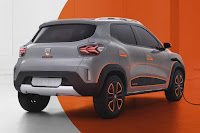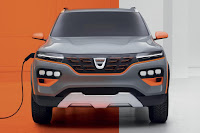Dacia is preparing to launch an electric city car
A new addition to the Dacia line-up is due to arrive at dealers next year. The Spring Electric – which is being previewed now in concept form – will be the brand’s first city car and its first pure-electric model.
Chunky SUV-inspired styling and a high ground clearance give a purposeful presence that belies some petite dimensions. In fact, with a body length of 3.73 m (12’ 3”), this Dacia slots neatly between the 3.62 m (11’ 10”) Renault Twingo Z.E. and the 4.09 m (13’ 5”) Renault Zoe.
Such context is meaningful, because most of the Spring Electric’s powertrain components are going to be taken from parent company Renault. Full specifications haven’t been revealed, but the WLTP range target is more than 124 miles (200 kilometres).
By comparison, the aforementioned Twingo Z.E. achieves 111 miles (180 kilometres) with a 21.3 kWh battery pack, while the latest 52.0 kWh Zoe records an impressive 245 miles (395 kilometres).
The Dacia seems destined to be used mainly for commuting and local journeys, although there is a danger that prospective customers might want better practicality. It’s eclipsed by some potential rivals, too. The Škoda CitigoE iV, for example, can travel up to 170 miles (274 kilometres) on a single charge.
Of course, prices are bound to play a significant role in determining the success of the Spring Electric, but those won’t be released for a while yet.
Related posts:
Dacia launches a petrol / LPG dual-fuel engine
Dacia SE Twenty special editions unveiled
Chunky SUV-inspired styling and a high ground clearance give a purposeful presence that belies some petite dimensions. In fact, with a body length of 3.73 m (12’ 3”), this Dacia slots neatly between the 3.62 m (11’ 10”) Renault Twingo Z.E. and the 4.09 m (13’ 5”) Renault Zoe.
Such context is meaningful, because most of the Spring Electric’s powertrain components are going to be taken from parent company Renault. Full specifications haven’t been revealed, but the WLTP range target is more than 124 miles (200 kilometres).
By comparison, the aforementioned Twingo Z.E. achieves 111 miles (180 kilometres) with a 21.3 kWh battery pack, while the latest 52.0 kWh Zoe records an impressive 245 miles (395 kilometres).
The Dacia seems destined to be used mainly for commuting and local journeys, although there is a danger that prospective customers might want better practicality. It’s eclipsed by some potential rivals, too. The Škoda CitigoE iV, for example, can travel up to 170 miles (274 kilometres) on a single charge.
Of course, prices are bound to play a significant role in determining the success of the Spring Electric, but those won’t be released for a while yet.
Related posts:
Dacia launches a petrol / LPG dual-fuel engine
Dacia SE Twenty special editions unveiled




%2BDashboard.jpg)


+Front+Side.jpg)

+Front+Side.jpg)

Comments
Post a Comment